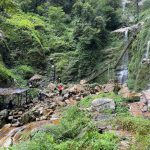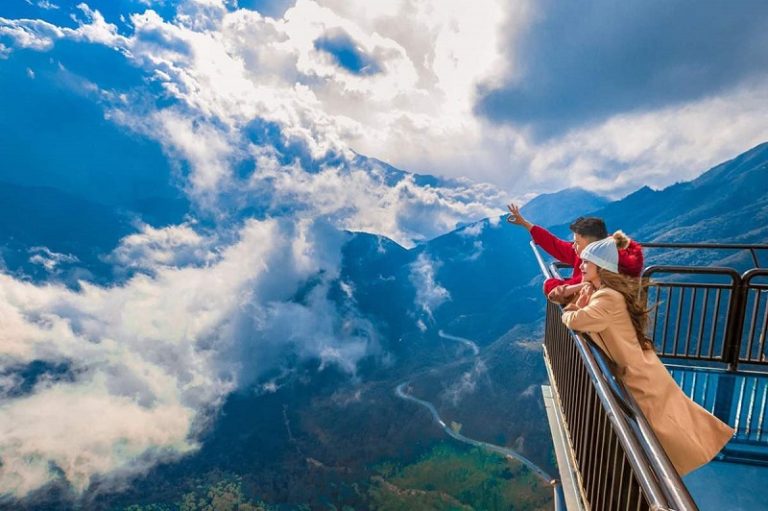Homestay & Trekking in Sapa – A Must Do Experience in Vietnam
Sapa Trekking For many Southeast Asian travelers, Vietnam is at the top of their bucket lists .
.
When is the best time to visit Sapa?
Spring lasts from March to June: Spring is one of the best times to trek in Sapa, with calm, sunny days. It is the time of year when plants and flowers get to bloom. It is also the time of year when the ethnic minorities in the area plant rice.
Summer / Rainy Season lasts from July to August: You can trek in Sapa during the rainy season; only wear a rain jacket because it is vulnerable to heavy downpours in the afternoon. During the rainy season, you will observe four seasons in one day! If lush green countryside and rainbows are appealing to you, this might be the ideal time to explore. There are also fewer people around at this time.
Autumn lasts from September to November: Autumn retains the lush green of the rice terraces (the rice is ready to harvest at this point) while being much drier than in the summer months.
Winter lasts from December to February: Winter in Sapa is a beautiful time; you can also see snow on the higher peaks! That being said, brace yourself for sub-zero temperatures at night!
What to pack for a Sapa trek?

Take only your daypack with you, packed with only the essential items that you’ll need during your trek.
Whatever bag you take with you, a waterproof backpack cover could be the difference between a positive trekking experience and a negative one, especially if it’s the rainy season! If you are taking an expensive camera or other electrical equipment a waterproof backpack can be a good idea.
From there, keep it simple, but don’t forget the following absolute essentials!
- Water: It goes without saying, no matter what season you’re travelling, you’re going to need plenty of water. Extra bonus responsible-traveller points go to anyone who takes a filtered water bottle with them.
- A Change (or two) of clothes: Don’t allow yourself to get drenched early on during your trek and then have to wear soaking wet clothes for the rest of the time! As your grandmother almost certainly told you, that’s how you catch a cold!
- Shoes: Comfortable walking shoes/boots with a good grip. Sandals/flip-flops the (for the evening). Rubber flip-flops for the shower. Check out our recommendations for the best travel shoes.
- Hiking poles/walking sticks: If you like to walk with them (on this tour, the guide provided us with one).
- Trekking socks: The thicker the socks, the less chance of blisters.
- Camera/mobile phone: Plus spare batteries/charger/camera bag. You’re bound to want to take some photos!
- Toiletries: Don’t assume you’ll find these things at a shop on the way, bring them with you.
- First aid kit: Never a bad idea.
- Personal medication: If you’re on medication, it’s probably best to carry on taking it, no matter how good that “fresh country air” is for you. If you have allergies, take some anti-histamine (or equivalent) with you.
- High factor sunscreen, lip protection, after-sun, sun hat and sunglasses: Wherever you are in Southeast Asia, you should be carrying these!
- Insect repellant & after-bite
- Hand sanitiser and/or anti-bacterial wipes
- Paracetamol: Both aspirin and ibuprofen are to be considered a no-no whilst in Asia, as their blood-thinning qualities can cause complications (ones you definitely don’t want to experience!) in the event of dengue fever.
- Dioralytes/dehydration salts: They weigh next to nothing and make a huge difference when they’re needed.
- Anti-diarrhoea pills: I don’t need to explain the value of this one.
Travel tips when visiting ethnic minority villages
Of course, every ethnic minority group has a slightly different set of morals, but there are some general rules that it’s best to follow just in case.
- Do not buy or use drugs: Drugs are illegal and Vietnam and you will not be doing yourself, or anyone else, any favours by buying or consuming them.
- Do not touch any sacred objects: You’d think this is obvious, but you’d be surprised by how many people think it’s OK and end up causing offence.
- Dress conservatively: Covering up legs especially, but also shoulders and arms helps ensure that you’re not going to be seen as disrespectful.
- Keep the noise down: Again, you’d think everyone would naturally follow this rule, but again, you’d be surprised…
- Only drink alcohol if you’re invited to: Grabbing some beers and separating off as a group to drink them could be seen as being “up to no good”. If you are invited to drink some rice wine (hint, you will be!), it would be rude not to accept. (Only joking, if you don’t drink alcohol it is fine to politely refuse!)
- Don’t kiss in public: Couples, curb your PDA! The Vietnamese are shy people and showing affection in public is not culturally accepted. Just wait till you’re in a more intimate setting.
- Ask permission before taking photos: If given permission to take one, show it to the people you have photographed afterwards.
- Do not enter anyone’s property unless invited: Would you do this at home?
- Do not give money or sweets to children: No matter how happy it makes them. Giving gifts to children encourages begging.
- Consider buying a souvenir: As mentioned above.





















